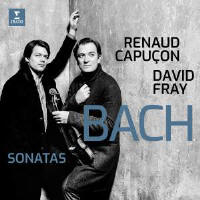Texte paru dans: / Appeared in: |
|
|
Reviewer: Robert
Maxham
Renaud Capuçon and David Fray
perform four of Bach’s six sonatas for violin and keyboard, in this case on
violin and piano. The choice allows both performers to indulge in subtleties
otherwise more difficult to achieve—Fray of course having available all the
dynamic possibilities the piano offers, but Capuçon being able to engage in
a dialogue with a fully equal partner. (Arthur Grumiaux, whose set has been
widely praised, played with the partnership of a cello, in some sonatas
perhaps anomalously, although he hardly represented himself as an exponent
of period authenticity.) Capuçon and Fray explore their modern expressive
capabilities not only in the slow movements (for example, the opening
movement of the F-Minor Sonata, with its interchange of highly nuanced
melodic gestures) but in the fast ones as well, in which the piano threads
its way through the contrapuntal complexities as nimbly (arguably more
nimbly) than any harpsichord could do. In the third movement, the
accompanying patterns with which Bach underlies the violin’s drooping
double-stops sound particularly engaging in Fray’s sprightly reimaginings of
them. He also manages to bring exceptional authority to the finale’s
keyboard part. Listeners can contemplate the competing merits (in some
philosophies) of two questions bearing on performance: First, what
instruments might the composer have intended, used, or tolerated, either
generally or at a particular time in a particular venue; second, what
combination of instruments allows the performers to explore their musical
ideas most widely and deeply and to express them most richly and fully. Many
may feel that doctrine should play a more humble part in that deliberation.
The use of the piano doesn’t create an unwelcome heaviness in briskly
flowing polyphonic passages, such as the fugal ones in the second movement
of the Sonata in E Major, and it only enhances the liquid lyricism of the
succeeding Adagio ma non tanto. The first movement of the C-Minor Sonata,
with its connections to the St. Matthew Passion, sounds arguably lighter and
airier on account of the piano’s participation, and the sonata’s Adagio
emerges as an especially affecting conversation. There’s a long tradition of performing and recording these works on modern violin and piano (Adolf Busch and Rudolph Serkin recorded some of them that way as early as 1929); and who wishes to see one orthodoxy supplanted by another? So, dogma aside, a strong positive recommendation for Capuçon’s and Fray’s perceptive and, at times, even revelatory performances is in order. The medium isn’t the message.
| |
|
|
|
|
|
|
|
Cliquez l'un ou l'autre
bouton pour découvrir bien d'autres critiques de CD |
|




